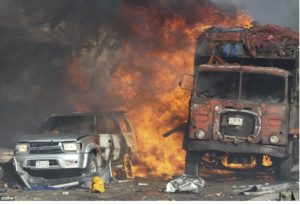By Joe Sommerlad, Independent
Al-Shabaab is the deadliest jihadi group in sub-Saharan Africa, largely operating in Somalia but known for brutal attacks on neighbouring Kenya.

Founded in 2006, the group – whose name translates from Arabic as the “The Youth” or “Mujahideen Youth Movement” – began as the militant arm of the Islamic Courts Union (ICU), an alliance of hard-line Sharia courts in southern Somalia who sought to rival the Transitional Federal Parliament for control of the country.
Al-Shabaab has long since spun off from the ICU and aims to overthrow the Western-backed successor Federal Parliament on its own, carrying out vicious suicide bombing attacks and other acts of brutality against “enemies of Islam” among the Horn of Africa’s Christian and Sufi Muslim population. Committed to ultra-conservative Wahhabi Islam, al-Shabaab intends to run Somalia in accordance with strict Sharia principles.
Al-Shabaab initially won popular support by pledging to bring security to a nation that has not had a stable government in 20 years, before losing face when its rejection of international aid made tough conditions worse for their people when the land was struck by drought and famine in 2011.
Al-Shabaab was driven out of Mogadishu that same year by troops from the African Union – a military alliance comprised of soldiers from Uganda, Kenya, Ethiopia and Burundi – and out of the port city of Kismayo in 2012, a huge blow since its cut from the charcoal trade through the docks had been a key source of income.
The group has been affiliated with al-Qaeda since 2012 when its previous leader, Ahmed Abdi Godane, pledged “obedience” to his counterpart Ayman al-Zawahiri in 2012. Gobdane was subsequently killed in a US drone strike and al-Shabaab is now led by Ahmad Umar, also known as Abu Ubaidah. He has between 7,000 and 9,000 foot soldiers at his command.
The militia is also thought to have ties to al-Qaeda in Islamic Maghreb and Boko Haram in Algeria and Nigeria respectively.
Al-Shabaab does not have links with Isis, however, having rejected them, a decision that caused a rift among its ranks and led to the formation of a splinter faction, Jabha East Africa, which recognises Isis leader, Abu Bakr al-Baghdadi, as the “rightful Khalifa of all Muslims”.
Having brought carnage to the region over the last decade, al-Shabaab is now recognised as a terrorist organisation by the UK, the US, Norway, Australia, New Zealand and the UAE.
One of its earliest atrocities was the bombing of a restaurant in Kampala, Uganda, on 11 July 2010, designed to coincide with the Fifa World Cup Final between Spain and the Netherlands, revenge for Uganda’s operations against it as part of the African Union. Seventy-four people were killed watching the game that night.
Kenya has been the victim of the majority of al-Shabaab’s assaults outside of Somalia, notably the attack on Nairobi’s upmarket Westgate shopping centre in 2013 that killed 62 civilians, five soldiers and four masked gunmen and in which British jihadi Samantha Lewthwaite, fancifully nicknamed the White Widow, was rumoured to have been involved.
Read more: Al-Shabaab: Who are the East African jihadi group and what are their goals?
Source: Independent


Leave a Reply